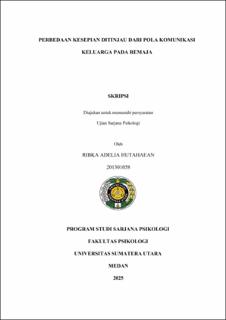Perbedaan Kesepian Ditinjau dari Pola Komunikasi Keluarga pada Remaja
Differences in Loneliness Reviewed from Family Communication Patterns in Adolescents

Date
2025Author
Hutahaean, Ribka Adelia
Advisor(s)
Nasution, Indri Kemala
Metadata
Show full item recordAbstract
This study aims to determine the differences in loneliness in terms of family
communication patterns that are categorized into four types, namely consensual,
pluralistic, protective, and laissez-faire in adolescents. Loneliness is an unpleasant
feeling that can be experienced by individuals and can occur due to a lack of social
relationships that are established, causing individuals to lose closeness and
intimacy in a relationship. Family communication patterns are the way family
members communicate and interact with each other and include the way they talk,
listen and understand each other. The research method used is a quantitative
method, with 347 adolescents aged 17-18 years as research subjects, selected using
the Incendental sampling technique. Data collection used a Likert scale consisting
of the UCLA Loneliness Scale Version 3 scale which measures loneliness and the
Revised Family Communication Pattern (RFCP) scale which measures family
communication patterns. Data analysis was carried out using one-way ANOVA to
test differences in loneliness in terms of family communication patterns in
adolescents. The results of the study showed that there were differences in
loneliness in adolescents in terms of family communication patterns, F(70, 276) =
1,55, p = .000, η² = 0,39. Post-hoc test showed that laissez-faire family
communication patterns had the highest levels of loneliness compared to those from
consensual, pluralistic and protective family communication patterns had high
levels of loneliness but not as high as laissez-faire family communication patterns.
This finding indicates that less supportive family communication patterns can
increase the risk of loneliness in adolescents.
Collections
- Undergraduate Theses [1428]
